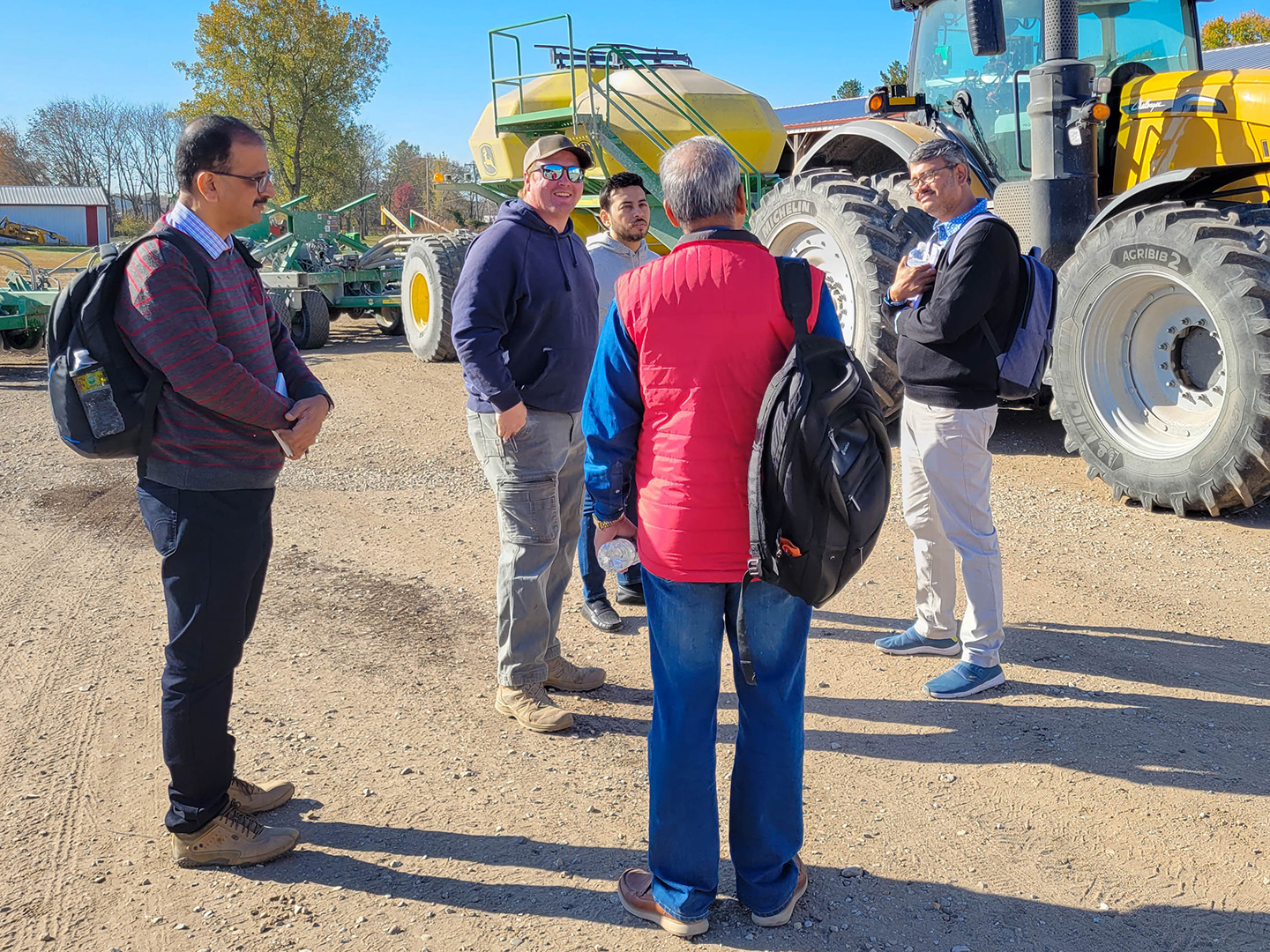
ISA farmer member Corey Goodhue (center) welcomes a trade team to his farm near Carlisle. (Photo: Brianna Schechinger/Iowa Soybean Association)
Trade team visits to Iowa build partnerships and preference for U.S. soy
October 27, 2022 | Brock Johnston
Consumer demand for protein is a key driver for the global soybean market. For U.S. soybean farmers, providing a reliable, high-quality commodity remains critically important as 60% of all homegrown soybean products are exported annually.
International buyers of U.S. soy witnessed how Iowa’s soybean farmers grow, store and market soybeans during a series of trade team visits in Baxter and Carlisle last week. Participants represented the countries of India, Nepal, Nigeria, Pakistan and Sri Lanka – all of which represent growing markets for U.S. soy.
“Farmers are the best advocates for our industry and buyers are always interested in hearing from them,” says Grant Kimberley, senior director of market development at the Iowa Soybean Association (ISA). “Buyers want to see and understand how soybeans are grown, stored and shipped all the way from the farm to the final destination.”
According to the Iowa Economic Development Authority (IEDA), who helped guide visitors to and through the visits, this relationship is mutually beneficially for Iowa soybean farmers and end users.
“As this second largest soybean producing state, Iowa is extremely important to the overall soy complex,” according to IEDA. “As exports are the most important market for U.S. soy, these countries represent rapidly growing markets to diversify Iowa’s export opportunities … these markets represent the future.”
Here are some perspectives on the markets represented during last week’s visits to Iowa:
South Asia
India
Predicted to become the world’s most populous country later this decade. As the world’s largest importer of vegetable oils and top importer of U.S. soy oil, many opportunities exist for U.S. soy to grow market share as the preferred source of imported soybean products within the country.
The U.S. Soybean Export Council (USSEC) has identified a preference for U.S. soybean meal, oil and food products in India, due to the quality, sustainability and economic feasibility of U.S. soy products. According to the October World Agricultural Supply and Demand Estimates report released by the U.S. Dept. of Agriculture, India is projected to import a record 3.55 million metric tons of soybean oil during the 2022-23 marketing year. GMO reluctance, tariffs and phytosanitary requirements all pose challenges to growing whole soybean imports into the country.
Nepal
Being a landlocked country, Nepal doesn’t have the infrastructure required to be a major logistical powerhouse, according to USSEC. However, bordering two of the world’s most populous countries, makes it a very unique market. A lack of government continuity is problematic for private sector confidence in deploying capital and developing Nepal’s poultry sector. USSEC in instilling that embracing trade is an effective method to satisfy Nepal’s food security needs.
Pakistan
Also in the process of installing a new government, following an ouster of the previous one. Like Sri Lanka, Pakistan is exploring all new options for food security and is in the middle of updating its biotech laws, especially for imports, according to USSEC. One of the key priorities is to continue to allow imported genetically modified soybeans in the country to satisfy their growing crush sector. Last year, Bangladesh and Pakistan ranked as the 13th and 12th largest export destinations for U.S. soybeans, respectively, according to IEDA.
Sri Lanka
The largest destination for containerized soybean meal, according to IEDA. The country’s ag sector chose to mandate all organic production, which led to the collapse of their food security, foreign exchange earnings, derived from exports and ultimately the country overthrowing and ousting their old regime, according to USSEC. Sri Lanka is exploring all new options to revamp their agriculture sectors and need to take full advantage of all available technological tools available, as well as bolstering trade ties with the U.S., according to USSEC.
Sub-Saharan Africa
Nigeria
Forecast to be home to the world’s largest city, Lagos, at nearly 80 million people by 2100. Rising populations, increasing urbanization and increasing disposable income in Nigeria make it an opportunity for marketing U.S. soy, according to USSEC. Expanded poultry consumption is driving demand for soybean meal as a preferred protein source for the poultry feed.
“Building relationships to develop customer preference for our soybeans and soybean meal is critically important in competing globally,” says Kimberley. “Global soybean demand is up by 264 percent since 1990, due in part to the work by our soybean organizations and international marketing export programs over the last 30 years.”
Back